| Sadly, this map is the best Wikipedia could do. I guess you can probably pick out that tiny green spot. |
Located in South Asia at the eastern end of the Himalayas,
Bhutan is a landlocked country of about 15,000 square miles and 700,000 people.
It is bordered by India and China and its climate ranges from sub-tropical to
sub-alpine. Almost everyone who lives in Bhutan (about 80 percent) is supported
at least in part by the agricultural industry, which produces various grains,
chilies, dairy and root crops, among other things. Bhutan has the great
distinction of being the first nation in the world to ban the sale of tobacco,
as well as one of the last nations in the world to introduce the television (its
nationwide ban on TV and the Internet wasn't lifted until 1999). How much this
has to do with the Gross National Happiness Index (and Bhutan is the only
nation in the world to measure such a thing) is anyone's guess, but I
personally would be pretty unhappy without Facebook and True Blood, so I'm
guessing it at least helped. Mostly, though, I think it's the food. Because
Bhutanese food is yummy.
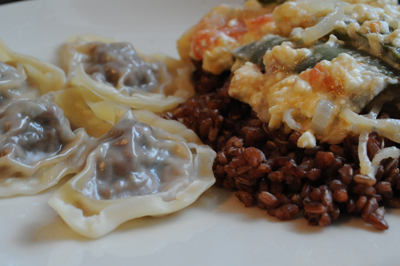 |
| Momo dumplings with ema datshi, served over Bhutanese red rice. Yum! |
Recipes from Bhutan were actually not that easy to find,
though, which is a shame because I would love to have a whole cookbook
full of them. I was lucky enough to find a couple of recipes that looked really
good, for the following reasons:
1.
Cheese
2.
Chilies
3.
Yak
OK you were probably with me up until I said "yak." But
after my very positive experience eating kangaroo burgers back in Australia, I
really wanted to try some yak. So I set out on a yak hunt that actually lasted
several weeks.
Surprisingly, yak is not that easy to find in my area, even
though it is farmed here in the US. My friends at Corti Brothers in Sacramento
couldn't get it, and although I did find one Sacramento restaurant that has it
on their menu I decided against calling them up to beg a pound off of them
since with the price of gas the drive down there would have actually cost more
than just ordering it, even with two day shipping.
The source I eventually settled on was a company called
Exotic Meat Market, which (among other things) sells a lot of really weird
things like crocodile, beaver, camel and lion. Yes, that's right, lion. Now in
case you were thinking that a lion steak sounds like it would really hit the
spot, an 8 to 12 ounce cut will actually set you back around 500 dollars. So I
didn't order any lion, because I don't have 500 bucks, but also because ew. I
did find ground yak meat on their site for $30 per pound plus $27 to ship.
Pricey, I know, but hey, you can't put a price on new experiences. Unless it's
500 bucks for a lion steak.
Now I did have some minor trepidation about ordering meat
over the Internet, since as you know I've ordered cheese online and had it
arrive warm. But my order actually came the very next day packed in a Styrofoam
container and still frozen solid. So it looks like I've found my new source for
weird meats.
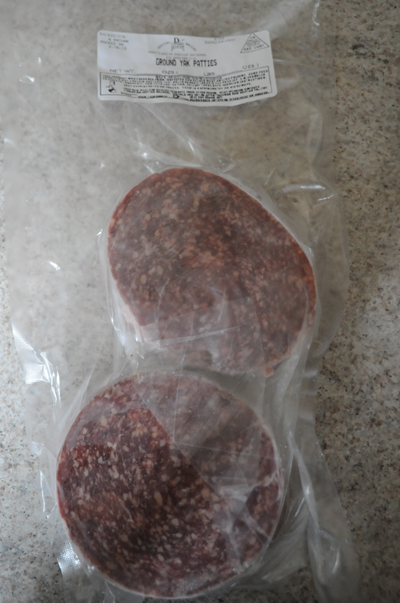 |
| Yak patties. I actually have two of these still in my freezer. |
 |
| In case you didn't believe me ... |
If you don't personally care to try yak or if you
just don't want to spend a foolish amount of money in doing so, they do
actually eat beef in Bhutan and beef is considered an acceptable substitute in
this recipe:
MoMo Dumplings
From ThingsAsian.com
For the dumplings:
- 1/2 pound ground yak or beef
- 1/2 onion, finely chopped
- 3 cloves garlic, finely minced
- 1 ounce xiaoshing (Chinese wine, found in most Asian grocers)
- 2 tsp flour
- 2 tsp soy sauce
- 1 jalapeno pepper, seeds removed, finely minced
- 1 package round wonton wrappers
- A few large lettuce or cabbage leaves
For the dipping sauce:
- 1/4 cup soy sauce
- 1/4 cup rice wine vinegar
- 1 tsp chili oil
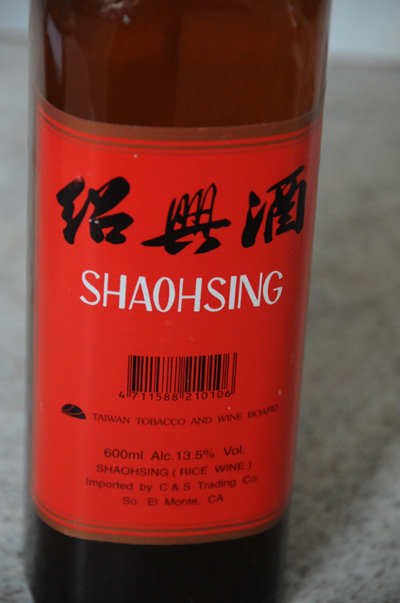 |
| This is xiaoshing, also called "shaohsing," among other things. |
The next recipe I chose is a fairly simple concoction of
chilies, tomatoes and cheese called "ema datshi," which is not only the
national dish of Bhutan but also the source of great Bhutanese pride. Traditionally,
ema datshi is made with—you guessed it—yak's cheese. So I set off on my next
quest.
Sadly, though, this time my quest was unsuccessful. I couldn't find yak's cheese online and I couldn't find it in any brick and mortar cheese shop. I finally
emailed Eddy Sanders from Grunniens Yak Ranch in Colorado (another source for yak meat, by
the way, though they were sold out by the time I was ready to place an order).
Eddy told me that there isn't anyone in the US producing yak cheese at this
time, mainly because regulatory requirements just don't make it practical to do
so.
So I decided to cheat, because I really wanted to make this
recipe. It's not like I've never cheated before, after all, and I usually try
to do it the way I think a national living outside of his/her country might do
it. So I poked around online and found some Bhutanese posters debating the best
US substitute for yak's cheese in ema datshi, and finally settled on a 50/50
combo of feta cheese and Danish blue, which at least a few Bhutanese
transplants agree is a decent substitute for the real thing.
So here is the Ema Datshi recipe, as shared by Kunzang Namgyel on "The Bhutanese Food Site," which has a small collection of authentic recipes. (My interpretations and changes are noted below).
- 9 oz chilie peppers, sliced lengthwise into four pieces each (I used jalapenos, which are roughly the same as the peppers used in Bhutan)
- 1 onion, sliced*
- 2 tsp vegetable oil
- 2 tomatoes, chopped*
- 4 1/2 oz feta cheese *
- 4 1/2 oz Danish blue cheese*
- 5 cloves garlic, crushed
- 3 stalks cilantro, chopped *
- 1 cup Bhutanese red rice
(*Recipe notes: Kunzang's recipe called for onions "chopped
longitudinally," which I took to mean sliced, since I've never actually seen
that word used in a recipe. The recipe also didn't say what to do with the tomatoes or
cilantro, so I assumed chopped. And as mentioned above, the combination of
cheeses I listed in this recipe is a result of my research on Bhutanese forums. Lastly, Bhutanese red rice is imported from Bhutan and
can be found at various online gourmet shops. I got mine from iGourmet.com.)
And finally, I did want to try doing a dessert, though I
couldn't find any referenced on any of the Bhutanese websites I found. I did
find a few desserts in the Bhutanese section of Recipes Wiki, though I don't
necessarily trust that they are authentic since (like all wikis) anyone can
post anything on that site and call it whatever they like. But I decided to do
one of them anyway, so if you are from Bhutan and know for a fact that my
choice is Just Wrong, please send me a note to let me know. Here it is:
Sweet Banana Soup with Tapioca
- 2 cups water
- 1/2 cup sugar
- 1 14-ounce can coconut milk
- 1/4 cup quick-cooking tapioca
- 2 large bananas, sliced into 1/2 inch pieces
- 1/2 tsp salt
The dumplings are the most time consuming of these three
recipes, so let's start there:
With your hands, thoroughly mix the ground meat with the
onion, garlic, xiaoshing, flour, soy sauce and jalapeno.
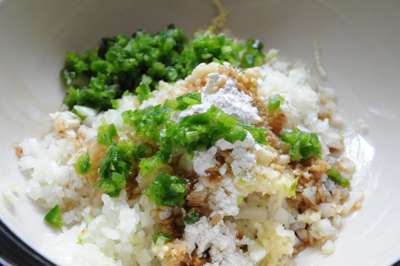 |
| The base for your momo dumplings. |
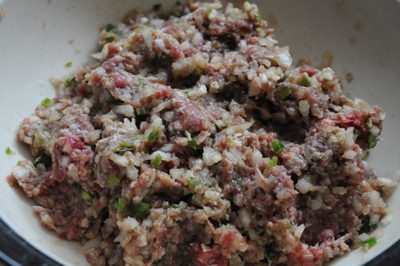 |
| Mix well with your hands. |
Lay out a few of the wonton wrappers and spoon a small
amount of the filling into the center of each. Fold the wonton wrapper in two
and then pinch the edges to make a tight seal. Alternately, the recipe says you
can "pinch the dough into a series of tiny pleats, gathering the edge together
into a tightly puckered rosette at the top." Like that's going to happen.
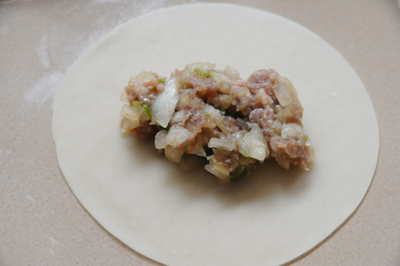 |
| First drop a small amount of filling onto the center of the wonton wrapper. |
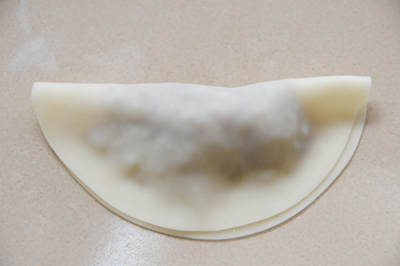 |
| Now fold in half ... |
 |
| ... and pinch the edges. Done! With one of them, anyway. |
After you've made about four million of these things, you
may take note of the fact that your bowl of filling does not appear to have
diminished in the slightest. I attribute this to some strange rift in the momo
dumpling space-time continuum, which you may want to ask Steven Hawking about
because I do not personally have any interest in understanding it.
So anyway, just ignore that sinking "this is never going to
end" feeling and keep making dumplings. Eventually, you will reach the bottom
of the bowl (I promise). In the meantime, avoid stacking your dumplings (as I
did in the following picture) because they do tend to stick to each other (the
wonton wrappers are tough enough that you can get them apart, but it's a little
challenging). If you are making them in advance, you might want to dust your
plate with a little bit of flour and just lay them down in a single layer.
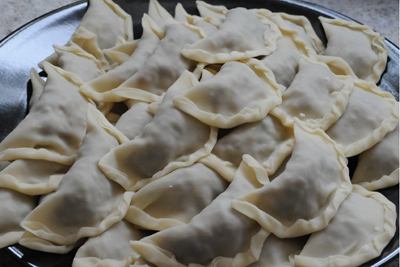 |
| My plate of dumplings. If you stack them this way, you will regret it. |
When you're ready to cook the dumplings, line your steamer
basket with the cabbage or lettuce leaves (the recipe says to use a bamboo steamer, but I used my electric one and it worked just fine). I'm still not sure what the exact purpose
of this step is, but I suspect it's to keep the dumplings from sticking, although
I think the cabbage leaves also lent a little flavor to the finished dumplings.
Put the dumplings on top of the leaves (don't let them
overlap) and steam for 30 minutes.
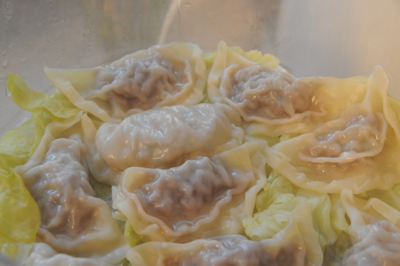 |
| Steam the dumplings for 30 minutes. |
Meanwhile, mix the dipping sauce ingredients. Serve the
dumplings hot with the dipping sauce.
The ema datshi comes together quickly, so you don't really
need to start making it until the dumplings are underway. Here's how:
First make the red rice, which takes about 20 minutes to
cook.
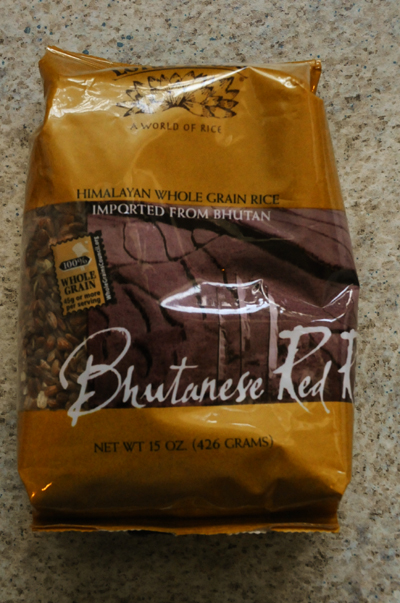 |
| This Bhutanese red rice came from iGourmet.com. |
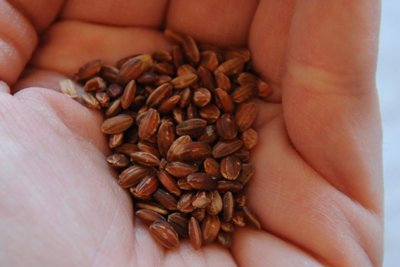 |
| It doesn't actually look a whole lot like rice. |
Add the rice and 1 1/2 cups of water to a medium sized pot and bring to a
boil. Reduce heat and cover. Simmer for 20 minutes or until all the liquid is
absorbed.
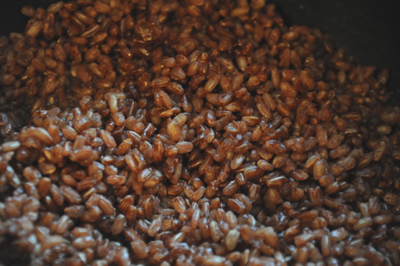 |
| It still doesn't look that much like rice. |
Meanwhile, put the chiles and onions into a pot with the
water. Add the vegetable oil. Bring to a boil and reduce heat to medium.
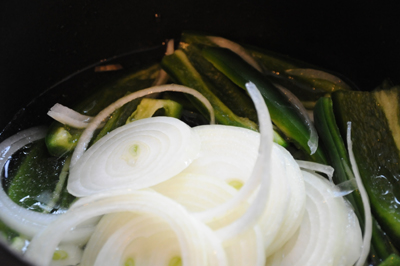 |
| These vegetables just need to be boiled in a little water with some vegetable oil. |
Boil uncovered for 10 minutes, then add the tomato and
garlic.
 |
| Add the tomatoes and garlic ... |
Continue to boil for 2 more minutes, then add the cheese
and cook an additional 2 to 3 minutes. Add the cilantro and remove from the
heat.
Stir and cover. Let stand for two minutes before serving
over the red rice.
 |
| It's not the prettiest dish, but it is oh-so-good. |
And finally the dessert, also simple:
Put the water and coconut milk into a medium saucepan and
bring to a boil. Then add the sugar, salt and tapioca.
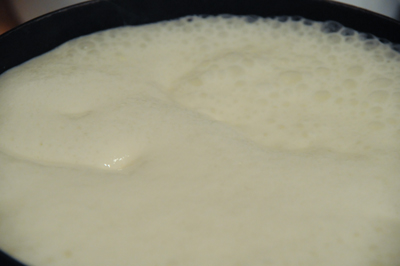 |
| Bring the water and coconut milk to a boil. |
Reduce heat to medium low and simmer for 30 minutes, stirring often. Add
the bananas, then remove from the heat and let stand for 15 minutes.
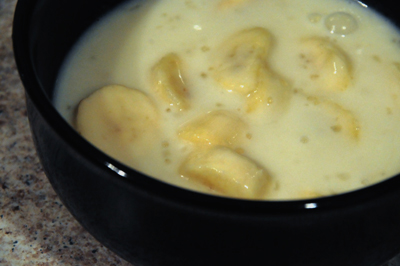 |
| Tasty, and light compared to most American desserts. |
You can serve this hot (as I did) or you can let it chill
it for a few hours.
So I know you are dying to hear what I thought of this
meal, because I didn't make it obvious enough early in the post with all that
talk about food being one of the keys to happiness. So I'll say it again: we
loved this meal. At least, Martin and I did. The kids really didn't care one
way or another. Dylan and Natalie ate their dumplings but couldn't be convinced
to go back for seconds, though they remained blissfully unaware that they were
eating yak (though I really don't know the word "yak" would have actually meant
anything to them anyway). They also ate the rice, though I just topped it with
a little feta cheese since I thought the ema datshi would probably be too spicy
for them. Henry wasn't interested in any of it, which is pretty out of
character for him, and Hailey was also not interested in any of it, which is
completely in character for her.
I thought everything was delicious. The yak was sweet and mild,
and although I thought I could detect a little gaminess I now think it was
probably just the differentness of it, since almost no one else says yak tastes
gamey. The ema datshi was oh-my-god good, and the red rice was slightly nutty
with a little bit of a chewy texture that was not at all unpleasant (reminiscent of brown rice, which I usually don't like). The banana
soup was good, too; it was light and fruity and made a nice change from all
those heavy Easter desserts we've been eating over the past week.
So yes, I have to say that overall my personal Gross
Happiness Index went up a bit this week. These recipes are going into my family
cookbook, which is good because I actually still have about 3.9 million momo
dumplings left in my freezer.
Next week: Bolivia
For printable versions of this week's recipes:











Loved this post, and just retweeted it - I lead tours to Bhutan and it is a great introduction to the basic chilies and cheese. I hope some day you will start tweeting your posts - bet you would be rapidly popular with the travel bloggers. Cheers! @BhutanChampaca
ReplyDeleteHi, I just commented on your most recent post and thought I'd come back to revisit your Bhutan post now I've been living here for 9 months. It looks like you strive really hard to be authentic, so I hope you don't mind my offering some comments on this post. I am not Bhutanese, but have eaten a lot of Bhutanese food this year, so that is my only qualitificatio(n!
ReplyDeleteIn my area (Bumthang, central Bhutan) all the cheese is made from local cows (yaks live in the highlands) and we buy it from the milk processing factory behind our house. It is mild, slightly sour in flavour and not at all salty, so quite similar to ricotta, but drier. I use a hand sized ball of this and most Bhutanese use processed cheese as well in their ema-datse and it gives it a characteristic flavour and texture - smooth.
The red rice you have look sreally different to the red rice here! The rice we eat is tinted red and has a lovely flavour and texture but is fairly similar to brown rice we have in Australia. It is not the deep colour like in your photo which is surprising.
And as for your dessert, it is nothing like I have seen here, in fact those ingredients are not available here (except in the import shop in Thimphu). I love coconut milk but it is not a Bhutanese product and can only be purchased in the capital imported from Thailand. I know why you had trouble finding a Bhutanese dessert - I am trying to think when one was served this year - and can't htink of a single one. Eating at a family home here is interesting. When you arrive, you are greeted with either sweet milky tea (naja) or butter tea (suja) and snacks - salty crackers, sweet biscuits and puffed rice and cornflakes. Then you have alcohol and dinner and more or less leave as soon as the food is finished - you don't linger as we do at home and don't have a dessert. In a way, the sweets are served first! I hope you don't mind my comments on your blog, but thought you would be interested.
Hi Andrea, of course I don't mind and in fact I love it when people from the countries I write about leave comments because it's so hard to find good information on the internet. Living in Bhutan makes you infinitely more qualified than I am. :)
ReplyDeleteI wish I'd known about the other cheese options when I made the ema datse, because all the sources I found led me to believe that it was always made with yak's cheese, which you can't get anywhere in the US. I did get the suggestion to combine a strong blue and feta from a message board for Bhutanese people living in the US, so I felt like it was at least a sort-of authentic choice, and I liked the results a lot (I've made ema datse a few times since then because we liked it so much).
The red rice I used is the only Bhutanese red rice I've ever seen here in the US, and the package said it was actually imported from Bhutan, but who knows what happens to it between here and there. Maybe they grow a different variety for export. That said I really, really loved that red rice and I keep buying it because it's got so much flavor. It is a bit like brown rice but I think it tastes nuttier.
Now the dessert, I'm not at all surprised to hear it's not Bhutanese. I got the recipe from a Wiki site which I now avoid unless there really is nothing, nothing, nothing out there because you just can't trust the accuracy/authenticity of those sites. I love to find recipes from bloggers who live in the countries I write about but sometimes it's really just impossible. I seem to recall that Bhutan was that sort of place--really not a lot of info online.
Do you have any Bhutanese recipes you could share? I'm collecting "corrected" recipes and suggestions from people like you and I like to post updates/additions when I can. That way these stab-in-the-dark type entries can be improved. Also I love what I've had of Bhutanese food so far and would really enjoy trying more. :)
Thank you for posting! I really appreciate the comments and corrections.
I've just returned from 15 days in Bhutan and agree with Andrea about desserts. We were camping most of the time with a crew of three travelling with us. These guys were trek chefs and never once made a dessert. Plus, in the capital, I bought the Authentic Bhutanese Cookbook by Punap Ugyen Wangchuk and there are no dessert recipes in it.
ReplyDeleteHello Every one.. I am Mr. Tenzin from Bhutan i would like to add a few things when it comes about the dessert.first of all it was very glad to know that you all are putting our country into popularity in the world, where as Bhutan country was unknown to every one.
ReplyDeleteDessert i would say yes, we don't serve it after a food, it's our traditional and culture that we haven't practice for a long time back so we are used to what we have it. But there is types of dessert in Bhutan, But it was served as a snacks during a especial occasion of festival and losars days. But i used to served as a dessert for a guest while i was working before. so if you required any recipe and wanted to try it do let me know at any time, i will send you all a recipe of few desserts which you all can try it. dosbtn.santos@gmail.com
I know you know it ... but that Ema Datshi is VERY hot! I actually coughed a couple of times when I took a sip. That'll cure a winter cold though I'm sure.
ReplyDelete